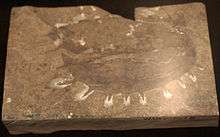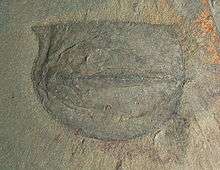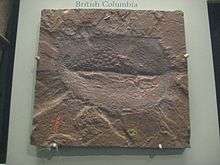Tuzoia
Tuzoia is an extinct genus of large bivalved arthropod known from Early to Middle Cambrian marine environments in what is now the Burgess Shale (British Columbia), Emu Bay Shale (Australia), Kaili (Guizhou, China), the Rockslide Formation (Northwest Territories, Canada), the Spence Shale, Wheeler Formation, and Marjum Formation (Utah), and the Kinzers Formation (Pennsylvania). This arthropod reached lengths of 180 mm long. There are currently 7 valid species recognized.[1][2]

Showing marginal spines
| Tuzoia | |
|---|---|
 | |
| Carapace of Tuzoia | |
 | |
| Museum specimen of T. polleni | |
| Scientific classification | |
| Kingdom: | |
| Phylum: | |
| Class: | |
| Family: | |
| Genus: | Tuzoia Walcott, 1912 |
External links
- "Tuzoia burgessensis". Burgess Shale Fossil Gallery. Virtual Museum of Canada. 2011.
References
- Vannier, J.; Caron, J.-B.; Yuan, J.-L.; Briggs, D. E. G.; Collins, D.; Zhao, Y.-L.; Zhu, M.-Y. (2007). "Tuzoia: morphology and lifestyle of a large bivalved arthropod of the Cambrian seas". Journal of Paleontology. 81 (3): 445–471. doi:10.1666/pleo05070.1.
- Julien Kimmig & Brian R. Pratt (2015). "Soft-bodied biota from the middle Cambrian (Drumian) Rockslide Formation, Mackenzie Mountains, northwestern Canada". Journal of Paleontology. 89 (1): 51–71. doi:10.1017/jpa.2014.5.
This article is issued from Wikipedia. The text is licensed under Creative Commons - Attribution - Sharealike. Additional terms may apply for the media files.